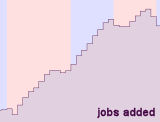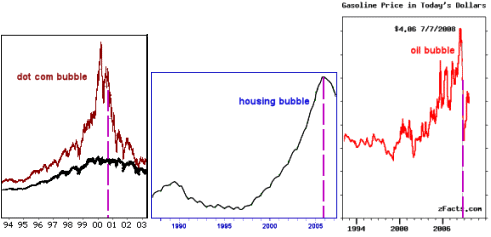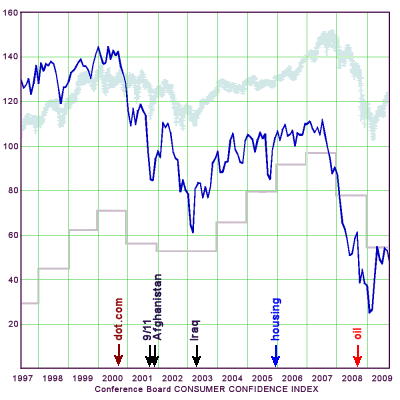I certainly am never going to be a Bush/Cheney apologist. They just weren’t leaders or governors. They came into office with a couple of agendas, the unitary executive, invading Iraq, the ‘Bush Doctrine,’ and eight months later, the sky literally fell on top of them. They used that attack to help them along their chosen path rather than dealing with the radically different world they were handed. By the end of their reign, the bottom literally fell from beneath them. Again, they said "no one saw it coming," just like they said about 9/11. In both cases, they were very wrong about that. They weren’t paying attention. They weren’t doing their jobs, neither one of them.
But since I’ve been looking at our Managed Depression, I’ve been obsessed with the "why" there were no jobs added during their time in office. The worst case scenario is the one I mentioned in an earlier post – that our consumerism and outsourcing has finally caught up with us. That’s a pretty gloomy conclusion because there is no solution, at least no quick [or even medium quick] solution. So I started playing with a timeline of this last decade. I will end up with a graph that was never intended to be put on the blog, but in the end, it was comforting – so I put it there in all its garbled glory [there’s a saying, "some of us are sicker than others"]. The graph made me feel more hopeful…
 We’ll never say the Bush years were boring. They started with the election controversy in 2000 and ended with our current Depression. In between, there was the nightmare of 9/11; two Middle Eastern Wars; enough dirty tricks for a two week seminar; and unimaginable economic wheeling and dealing. How all of that lead us to a financial crisis is increasingly clear, but the path out disappears into an impenetrable fog bank. The question is most often framed as, "where are the jobs going to come from?" In my last several posts, I documented and wailed about the fact that the net gain in jobs during the entirety of the Bush Administration was nada – zipola – near zero. Is America out of "job juice?" or did the Administration do something to hinder job production? or is it because of some unfortunate confluence of forces [something we can rectify]?
We’ll never say the Bush years were boring. They started with the election controversy in 2000 and ended with our current Depression. In between, there was the nightmare of 9/11; two Middle Eastern Wars; enough dirty tricks for a two week seminar; and unimaginable economic wheeling and dealing. How all of that lead us to a financial crisis is increasingly clear, but the path out disappears into an impenetrable fog bank. The question is most often framed as, "where are the jobs going to come from?" In my last several posts, I documented and wailed about the fact that the net gain in jobs during the entirety of the Bush Administration was nada – zipola – near zero. Is America out of "job juice?" or did the Administration do something to hinder job production? or is it because of some unfortunate confluence of forces [something we can rectify]?
Some of the economic gyrations had to do with financial "bubbles," situations where a market becomes irrationally inflated. There were three big ones:

The dot.com bubble "burst" around the time of the 2000 election [the graph is the NASDQ which paralleled the Internet stocks]. It likely precipitated the Recession of 2001-2003 – described as "shallow." As it turned out, the dot.com bubble was just the warm-up act for the housing bubble. We all know about it [the graph is a simplification of Shiller’s graph]. It "burst" in December 2005. And finally, there was an oil bubble that sent gasoline prices skyrocketing. It "burst" in the Fall of 2008 [along with everything else].
1boringoldman’s Crazy Graph:
I got to wondering about how the 9/11 attack, the Invasion of Afghanistan, the later Invasion of Iraq, the dot.com bubble, the housing bubble, and the oil bubble might have impacted the huge job deficit. Since jobs added come from expansion of existing businesses and the creation of new businesses, I started with the Consumer Confidence Index – reasoning that expansion or start-ups would occur during confident times. I’ll admit that I was curious about it anyway [because I haven’t personally felt confident for a single moment since Bush entered office]. That’s the blue line on the crazy graph [100 = the value in 1985]:

Then I added the arrows that marked the time the bubbles burst, 9/11, and the when we invaded Afghanistan and Iraq. The high consumer confidence marks of the Clinton era fell when the Tech Stocks tanked and dipped some with 9/11 and our foreign wars, but recovered pretty nicely. What was happening in the Stock Market, I wondered, so I cut out the DOW Jones Average for the same period, stretched it to fit, and pasted it lightly in the background [upper part of the figure]. It looked to me like Consumer Confidence and the DOW walked hand in hand [which makes infinite sense].
The bursting of the housing bubble itself didn’t seem to have much immediate effect. There was a chain reaction that had to play out before the real pain started. House values began to fall and those ridiculous sub-prime mortgages started coming due. Selling the house for a profit wasn’t working any more. In fact selling at all became increasingly hard. As the foreclosures and defaulted loans mounted, the Mortgage-Backed Securities where they resided fell in value or became worthless. Finally, the Banks that had "insured" these packages with Derivative Contracts had to pay them off – and they just didn’t have the money. Looking at the graphs, that took about a year and a half to play itself out. Then down we went like a brick. But it was another year before Lehman Brothers went belly-up, and the jig was finally up. I guess I knew all of that, but it helped to see it on a timeline.
But the point of the crazy graph was about the job deficit – which was, for me, something of a new discovery. I knew we had unemployment from the layoffs associated with our Depression, but I had no idea job creation was so stunted for Bush’s whole tenure. So, I took my job graph from a couple of posts ago [mini-version above] and cut out the right period, resized it, and added it to the background. It kind of makes sense to me now.
Jobs aren’t created in a downturn. That’s the usual state of affairs, but the 2001 downturn was complicated by 9/11 and our wars. I doubt many people felt secure enough in those few years to expand or start something new. I wouldn’t have done it. Around 2004, things were looking up and the jobs began to be created. In Reagan’s reign, he had seven years when job creation was positive. Clinton’s era was producing jobs the whole time. But George W. Bush only got three years [three lite years at that] before the consequences of the housing bubble made it to the front burner and we started the slide that ended in the cellar. I don’t know if the oil bubble bursting precipitated the Stock Market dive or vica versa. By then, it didn’t matter. The avalanche was unstoppable.
Why was I comforted by that goofy graph?:
There are reasons for the job deficit. It didn’t just happen because America had reached the end of her tether. Given that Bush had plunged us into two wars, and given that the housing bubble formed and was fed by Wall Street, and given that the insane Derivatives Market was available as a Casino for the speculators and large Banks, there wasn’t much Bush had to do with things [given that he and his advisers ignored the whole thing until it started screaming]. He’s not off the hook with me. Any competent President would’ve been looking into the housing bubble, the sub-prime mortgages, the credit default swaps, etc. long before it became malignant. To say, "we didn’t see it coming," is an admission of incompetence in my book.
But the economy was trying to grow in 2004-2006 in spite of things. It was creating jobs like it’s supposed to during the only time it could. The job deficit seems to be largely due to world events [9/11] and horrendous mistakes like Clinton going along with the deregulaters, repealing Glass-Steagall, electing Bush in the first place, not impeaching the entire White House along the way, invading Iraq – circumstantial rather than fundamental. I’m thinking that we have miles to go before we sleep, but at least there’s a road out there to find if we can deal with the fog.
Sorry, the comment form is closed at this time.